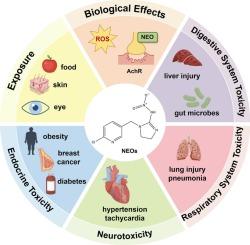Neonicotinoids and human health: Environmental fate, toxicity mechanisms, and future directions
IF 4
1区 农林科学
Q2 BIOCHEMISTRY & MOLECULAR BIOLOGY
引用次数: 0
Abstract
Neonicotinoid insecticides are among the most widely used agricultural chemicals globally, playing a significant role in controlling pests. However, their unintended effects on non-target species, particularly humans, have sparked global health and environmental concerns. This article reviews the environmental distribution, metabolic pathways, and mechanisms of action of neonicotinoids, as well as their toxicity to multiple human systems, including the digestive, respiratory, nervous, and endocrine systems. We dissect the molecular pathways linking neonicotinoid exposure to oxidative stress and apoptotic cell death, and discuss other potential harms, such as nephrotoxicity, cardiotoxicity, reproductive toxicity, pancreatic toxicity, and immunotoxicity. Additionally, we emphasize the importance of monitoring neonicotinoids and their metabolites and propose key areas for future research, including in-depth studies of toxicity mechanisms, assessments of combined toxicity effects, the development of biomarkers, and strategies to reduce environmental release and human exposure. The conclusion of this article underscores the necessity of taking multifaceted measures to reduce the environmental release and human exposure of neonicotinoids, as well as the urgency of conducting interdisciplinary research to fully understand the environmental fate and health impacts of neonicotinoids. Through these efforts, we can better protect human health from the potential hazards of neonicotinoids and promote the sustainable use of pesticides.

新烟碱类与人类健康:环境命运、毒性机制和未来方向
新烟碱类杀虫剂是全球使用最广泛的农药之一,在防治害虫方面发挥着重要作用。然而,它们对非目标物种,特别是人类的意外影响,引发了全球健康和环境关切。本文综述了新烟碱类化合物的环境分布、代谢途径、作用机制及其对人体消化、呼吸、神经和内分泌等系统的毒性。我们剖析了新烟碱暴露与氧化应激和凋亡细胞死亡之间的分子通路,并讨论了其他潜在的危害,如肾毒性、心脏毒性、生殖毒性、胰腺毒性和免疫毒性。此外,我们强调了监测新烟碱及其代谢物的重要性,并提出了未来研究的重点领域,包括深入研究毒性机制,评估联合毒性效应,开发生物标志物,以及减少环境释放和人类暴露的策略。本文的结论强调了采取多方面措施减少新烟碱类物质的环境释放和人类暴露的必要性,以及开展跨学科研究以充分了解新烟碱类物质的环境命运和健康影响的紧迫性。通过这些努力,我们可以更好地保护人类健康免受新烟碱类杀虫剂的潜在危害,并促进农药的可持续使用。
本文章由计算机程序翻译,如有差异,请以英文原文为准。
求助全文
约1分钟内获得全文
求助全文
来源期刊
CiteScore
7.00
自引率
8.50%
发文量
238
审稿时长
4.2 months
期刊介绍:
Pesticide Biochemistry and Physiology publishes original scientific articles pertaining to the mode of action of plant protection agents such as insecticides, fungicides, herbicides, and similar compounds, including nonlethal pest control agents, biosynthesis of pheromones, hormones, and plant resistance agents. Manuscripts may include a biochemical, physiological, or molecular study for an understanding of comparative toxicology or selective toxicity of both target and nontarget organisms. Particular interest will be given to studies on the molecular biology of pest control, toxicology, and pesticide resistance.
Research Areas Emphasized Include the Biochemistry and Physiology of:
• Comparative toxicity
• Mode of action
• Pathophysiology
• Plant growth regulators
• Resistance
• Other effects of pesticides on both parasites and hosts.

 求助内容:
求助内容: 应助结果提醒方式:
应助结果提醒方式:


